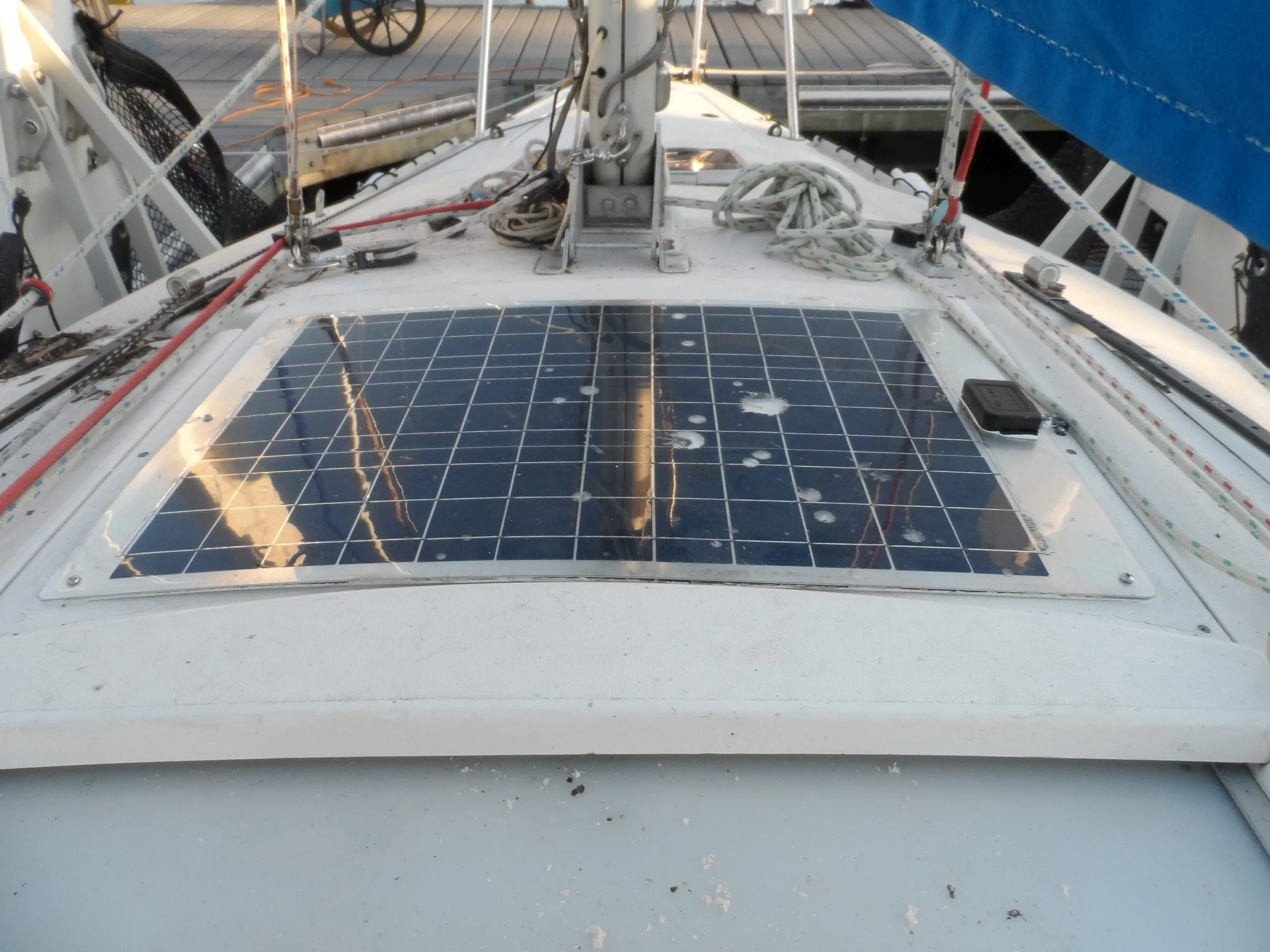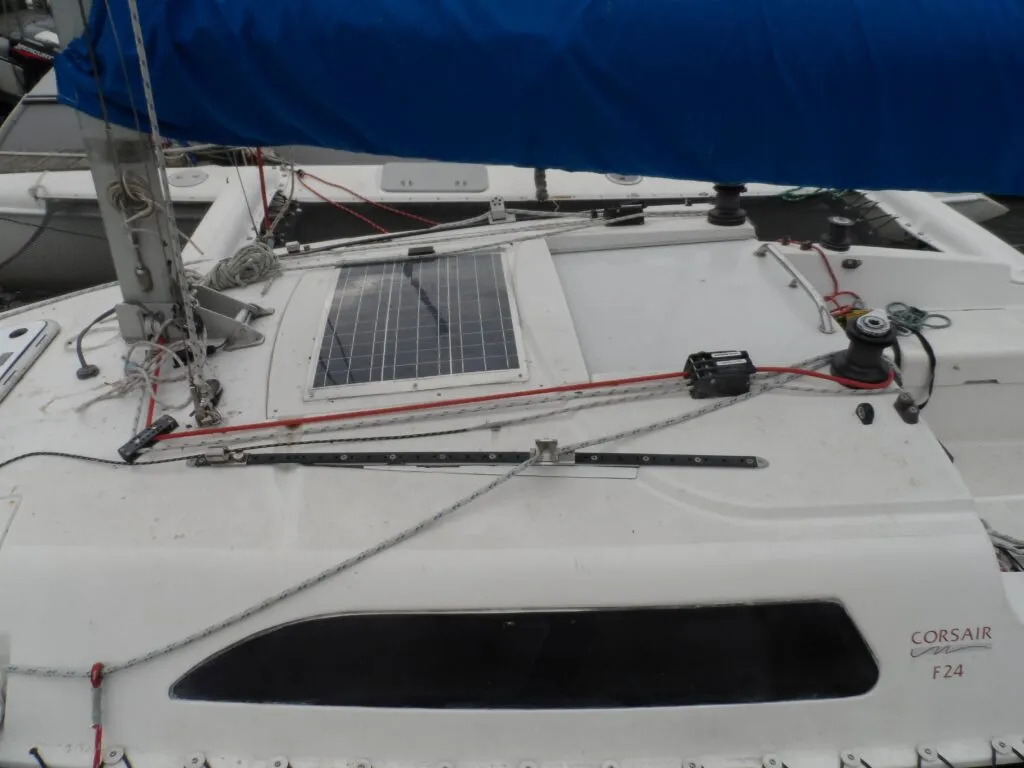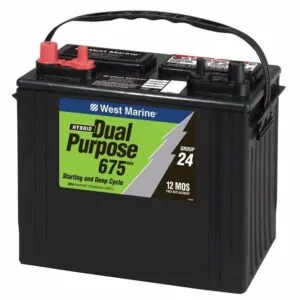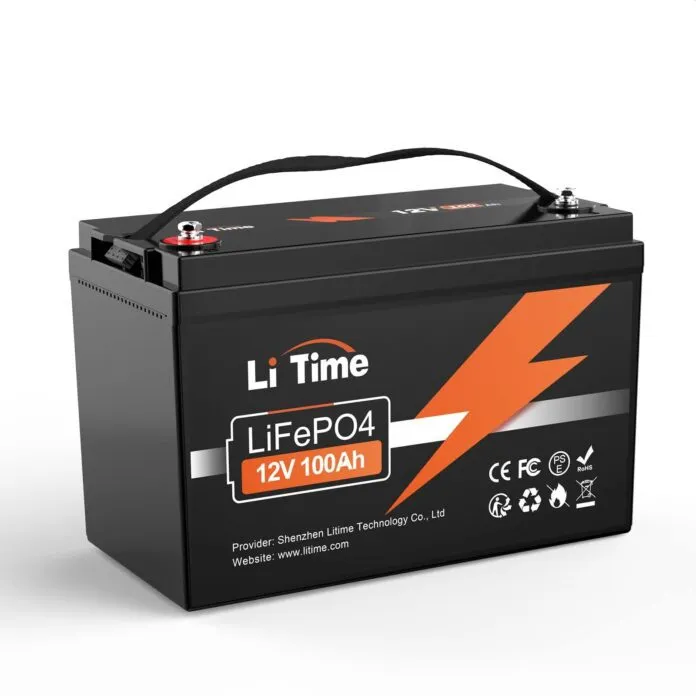Lithium is cool. Your cell phone uses it. Cameras, laptops, flashlights … everything. But “cool” is not a reason. Fire is not a big problem with properly installed lithium iron phosphate. ABYC finally signed off. And lately we’re even finding rock-bottom prices, matching lead acid, and with considerable advantages in capacity, depth of discharge, cycles, weight, and the potential for 50 percent more usable capacity in the same space. Is lead dead?
Lithium has solid advantages for large house banks and significant installation complications. See “Leaping into Lithium” and “What’s Involved in Setting Up a Lithium Battery System” for details.

But what about very small boats, including day sailers, dinghies that lift onto davits, and sport boats, all of which would love the weight savings? If only things could be that simple. We’ve heard about “drop-in” lithium and we’ve also been warned it is not that easy. Which is it?
This article is for simple systems:
- No high amp loads.. No windlass, no starter for anything over 9.9 hp, no big inverter. Remember that inrush (starting) loads are often 3- to-55 times higher than running loads, though only for a fraction of a second.
- No charging sources over 15 amps (think 150 watts of solar).
- No more than 2 batteries in parallel.
POSITIVES
- Weight Savings. A group-24 lead-acid (LA) battery weighs about 45 pounds, compared to 22 pounds for a same-size lithium battery with 40 percent more available power. The savings are even greater if a smaller lithium battery, by virtue of its deep discharge capability, works for you. Not too heavy in a keel boat, but a lot if you’re lifting a boat on davits or toting them around for charging. Or perhaps you’re spending money on Dyneema and carbon fiber to save ounces. If so, lithium is a bargain.

For a small boat, you don’t need a huge solar panel to play the lithium game. You can partake of lithium’s advantages with a modest buy-in. But bigger boats, bigger systems means more “output$$”. - Space Savings. About 40 percent more amp hours (Ah) in the same space, in part the result of being able to run the state of charge (SOC) much lower without damage or severe voltage drop off. Can you go to a smaller size?
- More Useable Power. Could be a big deal for a pocket cruiser with limited battery space. You did swap your lights for LED and add solar, since these are the first steps, before lithium. Didn’t you?
- Steady Voltage in Cold Weather. Lead-acid battery voltage drops severely in cold weather, to the point where only 25 percent is usable before some electronics start to cut out. The lithium curve is more level, both with regard to SOC and temperature.
- Longer Life. A lead-acid battery typically lasts about 3-7 years, depending on whether you ignore them or are obsessive about charger settings, keeping them topped, and maintenance. About 500-1200 deep cycles is realistic for most cruisers, no matter what the manufacture claims say. Lithium batteries, on the other hand, easily last 10-15 years and 4,000-10,000 deep cycles. Think about your cell phone (different chemistry) or EV (some are now LiFePO4, since the bad rap other lithium batteries got over catching fire). Double even for the non-cruiser.
NEGATIVES
- Cranking Loads. Most lithium batteries can’t handle high cranking loads (check the specs). Anything larger than a 9.9-hp gas outboard or any diesel is a concern. Figure on about 15 peak amps per HP to start a diesel motor, and about half that for gas.
- Can’t Charge Below Freezing. Most drop-in lithium batteries have a cold protection circuit that will block charging below freezing. Some have the additional feature of heaters inside the battery that will keep it above freezing, but this only functions if sufficient charging input power is available. Make certain the battery has some manner of low temperature protection and understand the limitations. Technically, you may read that lithium batteries can be trickle charged below freezing, but the rate is impractically low—less than 0.01C, or about 5 watts for a group-24 battery. Faster charging can quickly cause serious, permanent damage, so the smart answer is just no.
- Voltage Spike if the battery management system (BMS) disconnects for over voltage. Not an overly serious problem with solar under 100 watts and outboards that charge less than 10 amps. Regulators on the solar panel and outboard inputs should prevent this from occurring.
- Check Your Insurance. They may forbid lithium; we’ve seen a few, and whether that is “right” or not is irrelevant. They might require professional installation. Read the fine print. Mine did not ask.
- Recycling. Although battery recycling facilities got a black eye in the past because of sloppy practices, lead is, in fact, safe and efficient to recycle. Lithium batteries are not generally recyclable at this time, although that will likely change.
OTHER FACTORS
- Maintenance Free. AGMs and lithium are both maintenance free when charged and installed properly.
- Lithium Batteries Don’t Off Gas Hydrogen. Neither do AGM lead-acid batteries at low charging rates if mated to the proper charger, and all sealed batteries recycle that small bit back into water. They can overcharge and start to use water if they fail by internal short, but with reasonable monitoring this has not proven to be a serious risk factor.
- Faster Charging. Small boats don’t generally have a fast charging source.
- State of Charge Monitoring. Lead acid gives you more warning. You can watch the voltage curve. At some point an electronic devices will cut out because of low voltage, warning you to turn stuff off. Lithium, on the other hand, dies more suddenly. But cell phone apps provide excellent monitoring of lithium through the BMS, so you better know where you are, and electronics don’t drop out when the battery is a little low or a little cold.

The Renogy Wanderer Li 30A 12V PWM negative ground solar panel charge controller regulator with temp sensor. It works with lithium, sealed, gel, and and even flooded LA batteries. We found it on Amazon for under $30. - Dark Ship. If the BMS trips everything fails. No lights, no GPS, no appliances, and probably no engine (the engine itself may not need electricity, but ancillary equipment does and so motor interlocks typically require a battery connection). On a small boat this is probably a minor problem. You have a flashlight, you have paper charts (do you?), and the outboard is a pull start. If it was over voltage disconnect, wait, follow the instruction, and it should restart. Drain off a little power with lights and figure out why it overcharged. If low voltage, you should be able to restart it in the morning using solar (bypass the charger, since it needs to detect a battery). The problem is mostly avoided by using regulators to prevent overcharging.
- Storage While Away From the Boat. Lead acid like to be stored full, so we leave them on float. Another option is disconnecting them over the winter; they should lose only about 2-4 percent per month. The downside is that it is difficult for cruisers to keep batteries full or to fully recharge between cycles, because of the long-slow absorption phase of charging. Lithium is best stored at partial state of charge, perhaps 50-80 percent and we are warned not to leave lithium batteries on the charger after they are full (smart lithium chargers turn off). But realistically, we keep them at 100 percent charge at the dock, because who wants to head out with a partial charge? So we store them full and eat a very small lifetime reduction.

Why does lead still rule for starting batteries in cars, regardless of cost? Why do electric cars still use a small lead battery to run certain critical electronics? Dumb reliability and insensitive robustness. For internal combustion engines, and diesel or large gas motors on boats, lead batteries are better at delivering massive cranking amps without damage. It’s not that a lithium battery couldn’t be designed to deliver high power, it’s just that they have low internal resistance and thus be prevented from excessive draw, and it’s just simpler and more reliable to use lead. In the case of electric cars, lead offers a separate power source that is not vulnerable to the same automatic shut down risks that could cause you car to go dark (a scary prospect, hurtling down the freeway at 70 mph). And they work well below freezing without heating. Dumb, insensitive reliability.
According to the new ABYC e-13 standard, BMS disconnect is NOT a permissible charging control mechanism and disconnect should disable all charging sources at the warning level. In part, this is to prevent damaging disconnect voltage spikes, but fundamentally because the BMS disconnect is supposed to be the battery’s last line of defense, not a control mechanism or common event. The warning can be provided via Bluetooth to a cell phone. Of course, we don’t monitor our cell phones constantly while sailing (I hope), so solar, and an engine charging, must be regulated. The Dakota Dashboard looks good.
Outboard Charging. Not connecting to the motor alternator for charging is an option. If you have even a tiny solar system, and all you do is motor in and out of the marina, motor charging is probably a small part of the equation. For example, my 6-hp. Mercury might put out at 5 amps at full rpm, but at normal revs charging output measures only 2-3 amps. I run it for about 20 minutes each day, in and out of the marina or anchoring, so less than 1 Ah. On the other hand, the tiny 50 W panel that maintains my batteries puts out 10-20 Ah each day. I’d have to run the motor for 7 hours at WOT to match that, which is never going to happen.
Engine charging at low temperatures isn’t a big problem for most. We don’t go out when it’s below freezing. We can disconnect the motor.
No engine connection means no BMS dumps and no electronics-frying voltage spikes. A rise to 25 volts is commonly typical for 9.8-hp outboards charging at 3-10 amps. Solar, even regulated, can also spike to about 20 volts.
Solar Charging. Maximum Power Point Tracking (MPPT) solar charge controllers are vulnerable to damage from the surge if suddenly disconnected from the battery without disconnecting the panels first (it’s in the manual). Pulse width Modulating (PWM) controllers are less vulnerable to BMS disconnect surges, particularly if conservatively sized. The surge will be small if the panels are small. However, the BMS should never disconnect due to overvoltage if the controller is functioning properly and is programmed for lithium.
We don’t recommend charging lithium with solar panels in series. The controller can fail, sending 100 volts to the battery. The BMS is not built to handle this sort of abuse and can fail. This could also happen with LA, of course, but it is more dangerous with Li. Better regulators (Victron and Morningstar are two) have isolated designs that will not pass full voltage through at failure. But since we’re talking about small boats, you probably have only 1-2 panels and they are in parallel. Good.
Low temperature cut-off. Some drop-in batteries prevent charging below 32F, but check. The best winter practice is probably to disconnect all charging, including solar, until the battery temperature will stay safely above freezing. Since self-discharge is only about 2 percent per month in cool temperatures, as long as you fully charge the battery in the fall it should be fine. Although lead-acid batteries benefit from storage at 100 percent SOC, lithium optimally stored at 30-60 percent SOC. Wintering at 70-90 percent is fine.
What about sump pumps or other year-round demands on boat that are kept in the water? This is the main reason I stayed away from lithium; I keep the boat in the water, there is no shore power charger, and there is a bilge pump. In EVs this is solved by heaters that keep the batteries above freezing, until they run out of power to run the heaters. Because I don’t have a charger I cannot use self-heating batteries. In theory, a boat that is kept in the water is buffered against freezing, but I’ve found frozen bottles in my cabin many times, and even some crust in the bilge.
The simple answer is stay with lead. However, in practice, the problems are small. Over voltage charging is prevented by the charge controller. As for low temperature interrupts, the electronics are probably not on at night and we are not on the boat, and when we are on the boat, the cabin and batteries will be above freezing. Solar amperage is zero at night, and if we have been away from the boat the batteries are probably full and charging is finished.
The BMS should not be routinely relied upon to block low temperature charging and every solar charge controller manual says to disconnect the charging source first to avoid damage (BMS disconnect could damage the charger). Finally, a sudden disconnect could cause a voltage spike, damaging electronics. However, lithium batteries are now available with dedicated low temperature protection. They disconnect charging at low temperatures without shutting down. Because they continue to supply 12 V back to the controller, this does not violate the controllers disconnect requirement. Another solution could be small thermostatic relay between the solar panel and the controller, though user experience suggests this does not actually cause meaningful problems on smaller systems.
Examples of batteries with built in heaters. [https://www.litime.com/products/12v-100ah-group-24-bluetooth-lifepo4-lithium-deep-cycle-battery-with-self-heating, Group 24, 100 Ah, self-heating, $260] [https://nomadicsupply.com/dakota-lithium-12v-60ah-deep-cycle-1000-cca-starter-lifepo4-lithium-battery/, Group 24, 60 Ah, self-heating, $600]

Most of you are probably aware of the dive boat Conception that burned to the water, killing all of the passengers. First, let’s be clear that the lithium ion batteries in question were small personal electronics batteries, not the LiFFePO4 chemistry as discussed in this article. But a fire on a boat is serious and this deserves an update. There has been discussion (an ATF report) that the fire may have started in a rubber waste bin and not related to the batteries. https://maritime-executive.com/article/atf-fire-aboard-dive-boat-conception-started-in-a-trash-can.
There are two weaknesses in this theory. First, no ignition source was suggested, and since everyone had been asleep for hours, a hot cigarette or bit of galley waste seems unlikely. Second, the location was wrong, based on the NTSB investigation. Finally, about a year prior to the fire on board the Conception, a small fire involving a charging lithium-ion battery took place on board the similar vessel Vision; a passenger was able to extinguish the fire by unplugging the charger and throwing it in a rinse bin. Thus, the NTSB focus remained on the battery charging location. However, there was not enough left of the boat to make a definitive determination, and hence the suggestion of uncertainty. Based on multiple personal experiences with charging and small lithium batteries getting hot, we think the battery charging operation is most plausible, possible whether they were lithium or even other types.
However, if you read the NTSB report, they don’t actually conclude that the ignition source was the main cause of the disaster. The main causes were: Failure to maintain a watch. Although there were two escape routes from the bunk room, they both exited through the salon, which was engulfed in smoke and fire. “The National Transportation Safety Board determines that the probable cause of the accident on board the small passenger vessel Conception was the failure of Truth Aquatics, Inc., to provide effective oversight of its vessel and crew member operations, including requirements to ensure that a roving patrol was maintained, which allowed a fire of unknown cause to grow, undetected, in the vicinity of the aft salon on the main deck. Contributing to the undetected growth of the fire was the lack of a United States Coast Guard regulatory requirement for smoke detection in all accommodation spaces. Contributing to the high loss of life were the inadequate emergency escape arrangements from the vessel’s bunkroom, as both exited into a compartment that was engulfed in fire, thereby preventing escape.
“Due to the combustible nature of the vessel’s fiberglass-over-plywood construction, very little material above the main deck remained after the fire had been extinguished by the emergency responders. Examination of the recovered wreckage and debris did not yield any physical evidence relevant to the origin and cause of the fire.”
The important takeaways for recreational sailors? Install smoke and CO detectors, like you would at home. And make certain there are two means of escape from the cabin. The companionway is one, but the deck hatches must remain clear as well. No lashing deck gear over your escape route. https://www.ntsb.gov/investigations/AccidentReports/Reports/MAR2003.pdf
In hot weather and when the battery is nearly charged, the difference between battery voltage (while being charged) and panel Vmp voltage (maximum power point) become smaller and smaller. Finally, PWM controllers are simpler and tend be more reliable, making them commonly used for remote, industrial applications. They are also more resistant to damage from downstream disconnects. For a single 50-100 W panel PWM controllers make a lot of sense. They deliver more power in the morning, evening, on cloudy days, and in shaded conditions. They drain less at night and when covered with snow. This is not counter-conventional wisdom reasoning; Google the major makers, such as Morningstar, and they will say the same thing. For large cruising arrays, yup, MPPT is the way to go. https://www.morningstarcorp.com/faq/what-are-the-different-types-of-solar-charge-controllers/
CONCLUSION
Drop-in lithium is not quite that simple, even for a small boat. It’s more like “time to change for the future” and upgrade a few things along the way. Get a controller rated for lithium, but it can be a simple PWM one. Choose a battery with low temperature charging protection if that is a concern (a good idea anyway).
Is it worth it for your small boat? If lead acid is working and your needs are few, probably not. If weight matters, yup, now is the time. And for all of us, I’m pretty sure that the next time we change batteries it will be time for an upgrade.

































If you decide to switch to Li batteries make sure you or your marine electrician evaluate the entire system, (batteries, charging, circuit protection, battery switches, wire sizes, stowage location, ventilation, etc.) Your electrician should be familiar with the ABYC E-13 recommended practices. A major note here is don’t buy the cheap Li battery on line and think you can safely build your own system. The ABYC standards require that the battery be certified by UL or other recognized standards testing agency. The “cheap” non-namebrand Li batteries most likely do not meet the UL testing standards. The home made battery definitely would not pass muster. When you notify your insurance company of the “upgrade” they will likely require that you have a certified marine electrician inspect the installation to ensure it meets the ABYC E-13 standard. If you don’t notify the insurance company you may find that you are not covered if an accident happens.